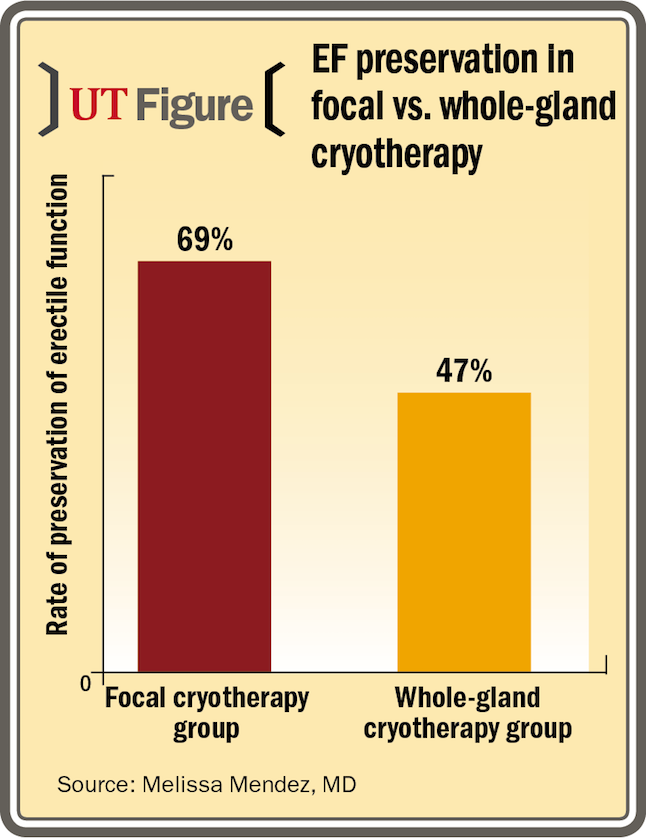Article
Focal, whole-gland cryo yield similar cancer control
Among men who are potent and have low-risk prostate cancer, focal cryotherapy appears to deliver similar oncologic control but with much better recovery of erectile function than a whole-gland approach, according to an analysis using data from the Cryo On-Line Data Registry.
New Orleans-Among men who are potent and have low-risk prostate cancer, focal cryotherapy appears to deliver similar oncologic control but with much better recovery of erectile function than a whole-gland approach, according to an analysis using data from the Cryo On-Line Data (COLD) Registry.
READ: Prostate Ca radiation therapy cost drivers analyzed
The retrospective study was presented at the AUA annual meeting in New Orleans. It included 317 men who underwent focal cryotherapy and 317 age-matched men who had whole-gland cryotherapy between 2007 and 2013. Men were selected for inclusion in the study if they had low-risk prostate cancer (Gleason score ≤6, initial PSA <10.0 ng/mL, and <cT2b) and were potent prior to treatment.

Oncologic outcome was assessed based on biochemical recurrence (BCR) using Phoenix criteria. At 60 months, the Kaplan-Meier estimated BCR-free survival rate for the focal group was non-inferior to that for the men treated with a whole-gland approach (80.1% vs. 71.3%, respectively; hazards ratio 0.827, p=.5), reported first author Melissa Mendez, MD, clinical research fellow at Duke Cancer Institute, Durham, NC.
READ: Biomarkers offer insight into PCa racial disparity
Functional outcomes were evaluated at 24 months. At that time, there were almost no men in the focal and whole-gland groups with urinary retention (0.9% and 0.6%, respectively) or urinary incontinence (0% and 1.3%, respectively), and there was a single man in each group who had a fistula. However, the rate of preservation of erectile function was significantly higher among men who had focal cryotherapy than in the whole-gland group: 69% versus 47%, respectively.
“Future validation studies are needed to evaluate the long-term oncological outcomes for these procedures in comparison with prostatectomy and radiation therapy. Another important next step will be to contemporize the patient population to include intermediate-risk disease as low-risk prostate cancer patients are now more commonly referred to active surveillance,” said Dr. Mendez, who worked on the study with J. Stephen Jones, MD, and co-authors from Cleveland Clinic, Moffitt Cancer Center in Tampa, FL, and Duke.
NEXT: Focal cryo 'could be an attractive option'
Focal cryo ‘could be an attractive option’

“So, while there is more work to be done, this report represents the largest study of cryotherapy outcomes to date. The initial results are promising and suggest that for men with focal disease, focal cryotherapy could be an attractive option for preserving quality of life while providing good disease control,” Dr. Mendez told Urology Times.
READ: No significant link between diabetes Tx, bladder Ca
The men included in the study had a mean age of 66.5 years. About 80% of men in both groups had a baseline PSA of 4.0 to 10.0 ng/mL. Data on erectile function at 24 months were available for about half of the men in each group, whereas data on urinary function at 24 months were available for about 95% of the cohort. Urinary retention rates at 6 and 12 months after treatment were 7.3% and 1.9%, respectively, in the whole-gland group and 5% and 1.3%, respectively, in the focal cryotherapy group.
Dr. Mendez noted that a limitation of the COLD registry is that cryoablation is categorized only as partial gland or whole gland, so there is not granularity to delineate types of focal therapy in terms of whether it was performed as a targeted focal ablation or a hemi-gland approach. She suggested that the majority of men included in the study’s focal therapy group probably had hemi-gland treatment, which may explain why the erectile function preservation rate was not higher than 69%.
READ: Upfront chemo called ‘standard’ in hormone-naïve PCa
Another limitation is data on erectile function in the COLD registry can be physician or patient reported, but it is not required to be derived from validated questionnaires.















